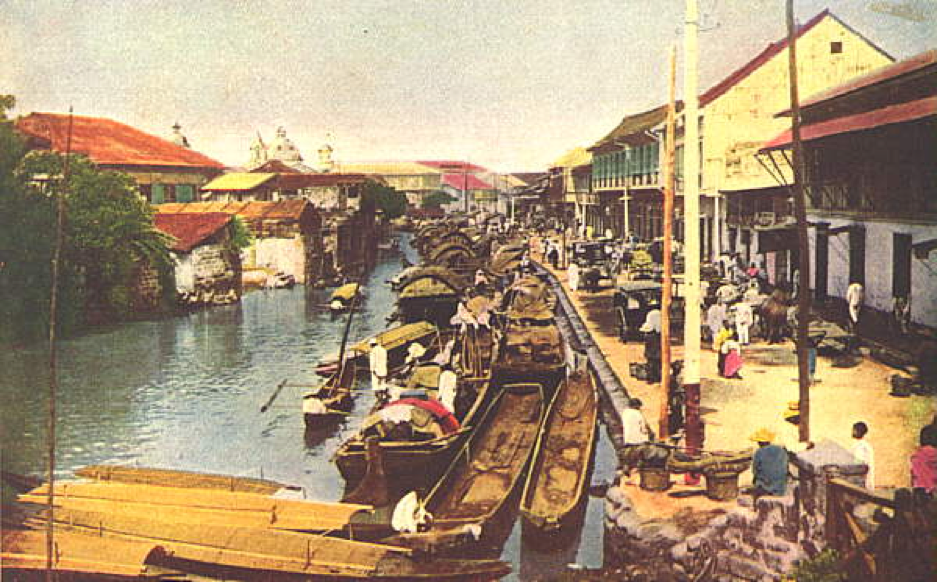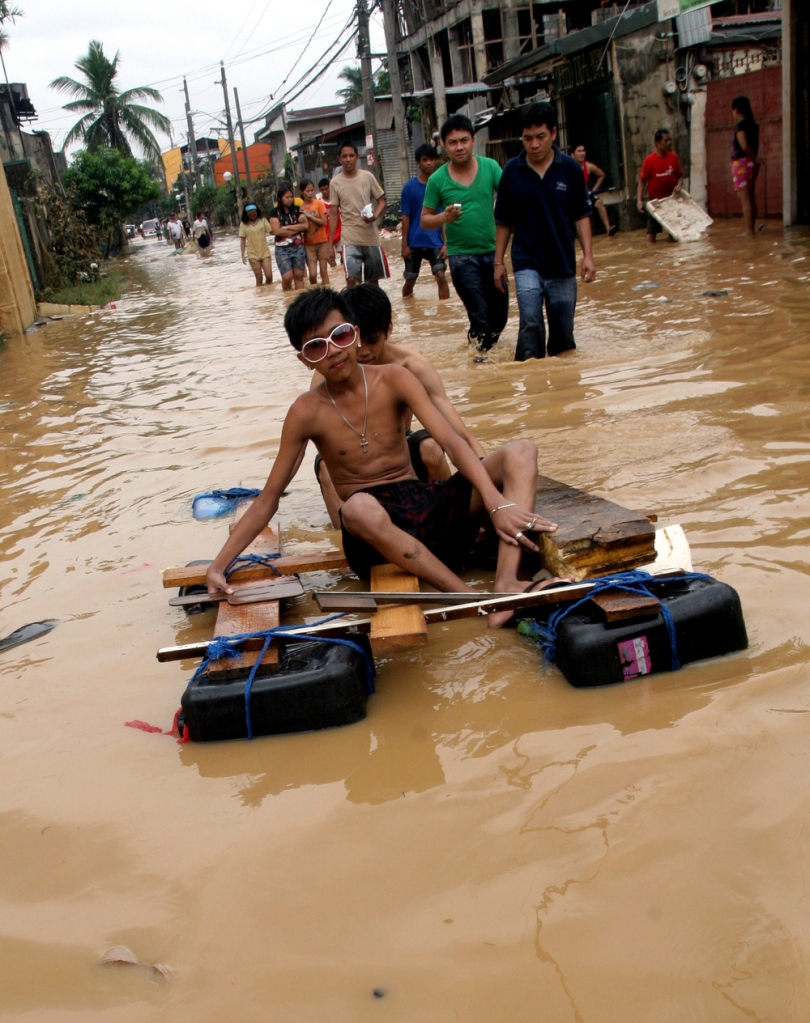The Pasig River plays a vital ecological role for the city of Manila, connecting the two bays that open the city respectively to Asia and the Pacific. Manila was founded by the Spanish settlers as a strategic trading point. The Pasig River allowed goods from all over the Spanish Empire to be transported through the city. The river’s tributary system structured the life of the city and its inhabitants (Macas 2014).
Unfortunately, the river has largely been the victim of the city’s great demographic boom. Far from the bucolic waterway that once made up its charm, the river has become a symbol of the mismanagement of natural resources in Greater Manila.

Source: Picturesque Old Philippines
The river is now infested with chemicals, covered with floating plastic waste and hyacinth, making maritime transport difficult. The Pasig River was declared ecologically dead in the 1990s (Gorme et al., 2010).
The dramatic consequences of pollution in the Pasig River are felt in the city in many ways. Water quality in Manila is not simply an environmental issue: it is an issue of public health and quality of life for the most vulnerable inhabitants.
Manila is hit by more than 10 typhoons per year on average (World Bank 2009). When water flows in the city, pollution causes sewers to become clogged and prevents the efficient flow of excess water. Tributaries filled with organic matter overflow and flood the precarious dwellings of communities illegally settled on the banks. Following Typhoon Ketsana in 2009, an outbreak of leptospirosis affected large sections of the population forced to wade through contaminated water (IRIN 2009).

Source: IRIN News
This phenomenon is largely catalyzed by land scarcity: the Pasig River flows through poor and dense cities, including the old city of Manila, known to be the most densely populated in the world. Land prices rose exponentially in the 1990s, and newly built private mixed-use developments have pushed away the most vulnerable to settle on hazardous land, in low-lying areas (Shatkin 2004). On coastal and river lines, informal settlements without permits have been expanding dramatically (Porio 2011). Meanwhile, residential and commercial developments have increased flood risks due to the disappearance of traditional waterways (Porio 2014).
Sewage systems are especially difficult to establish in hardly accessible riverlines, so that informal settlers resort to private septic tanks, whose structure and maintenance is often substandard. Many of them are made of plastic – not cement – and thus constitute a threat for public health and the urban environment. According to Porio (2014), the inhabitants lack the means to rebuild more resilient housing. As much as 83% of the victims of floods following typhoon Ketsana had no social security coverage (World Bank 2009), notably because 40% of Manila’s population is employed in the informal sector of the economy (Shatkin 2004).
The mismanagement of the Pasig River is closely linked to Manila’s political choices. Indeed, the privatization of water networks has prevented the creation of an efficient sewerage system in these areas. In 1997, when Manila Waterworks and Sewerage Systems (MWSS) was privatized, the companies promised to achieve 67% sewer connection coverage by 2021. By 2017, the proportion of household wastewater undergoing treatment was only 12% (Palanca-Tan, 2017) because there is no strong economic incentive for companies to provide universal coverage. The poorest families are tempted to dispose of their wastewater in the river because they can’t afford to pay their connection to the sewer system, set to 100 pesos per month (2USD). Most importantly, “pirate networks” – illegal connections to the water and sanitation system (Sundaram, 2010), multiply as a consequence of the high price of drinking water. These autonomous coping methods generate water leaks and increase the risk of flooding. Besides, Local Government Units (LGUs) are competing to attract private investment in Manila’s decentralized framework (Porio 2012). Consequently, they often relax compliance standards. Weak enforcement against industrial dumping is responsible for much of the river pollution.
Climate change mitigation and adaptation, waste management and rehabilitation of the river tributaries are mostly lead by international agencies like the World Bank and the Asian Development Bank (WEPA 2018) because they have sufficient financial and technical means to implement their solutions in local communities and make use of public-private partnerships. With the help of INCLAM, a water engineering firm based in Spain, the Asian Development Bank has developed innovative “condominial sewage systems” – large-capacity underground septic tanks – where wastewater is treated. Its organic substance serves as nutrients for the surrounding vegetation (Valermo 2016).
Within Public-Private Partnerships, international organizations also use rooted community-based organizations (CBOs) as intermediaries with the population to limit financial risk. CBOs are responsible for the local logistics around the condominial sewage systems, but also for the regular cleaning of the waterways by teams of “River Warriors” – Residents trained and paid to make the river trash-free. River Warriors managed to make the area a flood-free environment and public health has improved significantly in recent years (ADB 2010).
Source: Asian Development Bank: The Pasig River: Reviving a Dead Water in the Philippines
The main dimensions of sustainable development, namely economic development, environmental protection and social inequalities, are revealed through challenges and initiatives in place around the Pasig River’s ecology and human security. Public policies must grasp Manila’s pre-existing vulnerabilities to achieve efficient and fair resilience.
Wordcount: 859
Resources used:
Featured Image: pasig River Watch (March 10, 2011). Pasig River: Before and After. Retrieved from: https://pasigriverwatch.wordpress.com/2011/03/10/updates-on-pasig-river/
Asian Development Bank (2010). Philippines: Pasig River Environmental Management and Rehabilitation Sector Development Program. Completion Report. Retrieved from: https://www.adb.org/sites/default/files/project-document/62108/30308-02-phi-pcr.pdf
Disasters: Deconstructed Podcast Season 1, Episodes 10 & 11. Retrieved from: https://disastersdecon.podbean.com/.
Gorme, J., Maniquiz, M., Song, P. and Kim, L. (2010). The Water Quality of the Pasig River in the City of Manila, Philippines: Current Status, Management and Future Recovery. Environmental Engineering Research, 15(3), 173-179.
IRIN News (2009). Flood victims grapple with Leptospirosis. Retrieved from: http://www.thenewhumanitarian.org/news/2009/10/28
Macas, T. (2014). Burnham’s century-old ideas can still be used to improve Manila. GMA News Online. Retrieved from: https://www.gmanetwork.com/news/lifestyle/content/383820/burnham-s-century-old-ideas-can-still-be-used-to-improve-manila-architect/story/
Porio, E. (2011). Vulnerability, Adaptation, and Resilience to Floods and Climate Change-Related Risks among Marginal, Riverine Communities in Metro Manila. Asian Journal of Social Science, 39, 425-445.
Palanca-Tan, R. (2017). Health and water quality benefits of alternative sewerage systems in Metro Manila, Philippines. Environment & Urbanization, 567-580.
Porio, E. (2012). Decentralisation, Power and Networked Governance Practices in Metro Manila. Space and Polity, 16(1), 7–27.
Porio, E. (2014). Climate Change Vulnerability and Adaptation in Metro Manila: Challenging Governance and Human Security Needs of Urban Poor Communities. Asian Journal of Social Science, 42(1), 75-102.
Redclift, Michael (2000) “Addressing the Causes of Conflict: Human Security and Environmental Responsibilities”. Review of European Community and International Environmental Law 9(1), 44-51.
Shatkin, G. (2004). Planning to Forget: Informal Settlements as “Forgotten Places”. In Globalising Metro Manila. Urban Studies, 41(12), 2469–2484.
Valermo, A. (2016). Cleaning Up Manila’s Pasig River, One Tributary at a Time. CityLab. Retrived from: https://www.citylab.com/environment/2016/06/cleaning-up-manilas-pasig-river-one-tributary-at-a-time/488885/
Water Environment Partnership in Asia (2018). Pasig River. Policies. Retrived from: http://www.wepa-db.net/policies/measures/background/philippines/pasigriver.htm
World Bank (2009). “Philippine Typhoons Ondoy and Pepeng: A Joint Assessment”. Sector Reports. Typescript.
World Health Organisation (1997). Water Pollution Control – A Guide to the Use of Water Quality Management Principles. Case Study III – The Pasig River, Philippines.

Hi, thank you for this post! It’s fascinating to see the interconnectedness of water pollution with public health issues, climate change, natural disasters and further economic and political factors. I’ve written a similar post on Nairobi’s informal settlements. One of the main reasons for why Nairobi’s river pollution is still persistent is Nairobi’s non-existent disposal system.
I was wondering whether there is a disposal system established in Metro Manila? If so, do informal settlers have access to this disposal system somehow? I assume they don’t considering the rivers’ pollution, but I’m looking forward to what you say!
LikeLike
Hi, no as you can imagine, there is no established disposal point. Many atomized initiatives are in place, but rather than a disposal point, the city lacks a proper waste collection system, that would adequately segregate recyclable waste and set up routes for waste collecting trucks. The municipal waste collection system only covers a small part of the city and certainly not th informal settlements around the river. A big activity is informal waste picking, which is organized in a complex network, including both children picking up PET bottles on the ground and adapted trucks carrying plastic waste, cleaning it and shiping it to China. This system is far more efficient than one would imagine. As I worked in a start-up trying to set up a circular economy system of waste collection, recycling and reselling in Manila, I soon realised that matching the informal sector’s productivity would constitute an enormous challenge. However, the problem with Manil’s informal waste management system is that it leaves the most imortant part of waste behind. Indeed, most materials lack recycling “potential” and waste-pickers don’t bother treating them because they are to hard to value on the recyclate market. This unrecycled waste (including most plastics, organic waste, …) ends up in the river, the sea or in saturated landfills (… so eventually the river and the sea as soon as it rains)
LikeLike